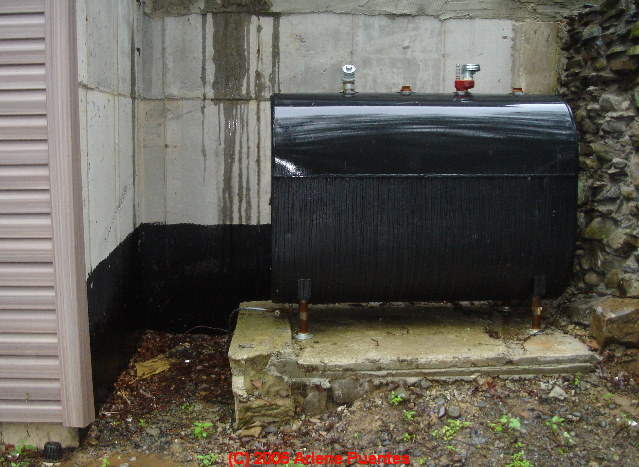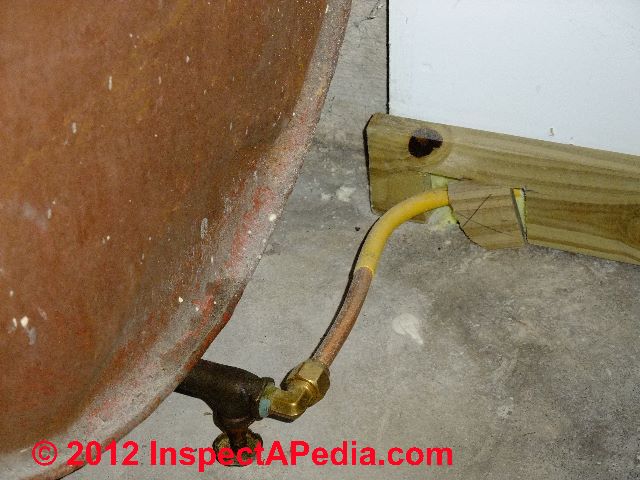 Heating Oil Tank & Piping Sludge
Heating Oil Tank & Piping Sludge
Part 6: when to replace a sludge or water-contaminated oil storage tank
- POST a QUESTION or COMMENT about heating oil tank sludge, clogs, and relating heating equipment malfunctions
Sludge & crud or contaminants in heating oil storage tanks:
We continue with oil tank & oil piping replacement options when sludge, rust, crud or water in the oil storage and delivery system are causing trouble.
InspectAPedia tolerates no conflicts of interest. We have no relationship with advertisers, products, or services discussed at this website.
- Daniel Friedman, Publisher/Editor/Author - See WHO ARE WE?
Should You Replace the Oil Tank Because it Contains Sludge?
Replacing a sludged heating oil tank is a last resort: even though your oil company will take the safe route and recommend this much more costly solution, you may not need to replace your sludge-contaminated heating oil tank UNLESS the heating oil tank is itself one that should be replaced for other reasons anyway, such as:
- You have an oil tank which is buried and can be replaced by one that is indoors and less of an environmental risk.
- You have an oil tank which is leaky and needs replacement anyway.
- You have an old oil tank which is not yet leaking but is in badly rusted condition with indications that rust perforation is a serious risk.
What the Oil Company Recommends for Sludgy Old Oil Tanks
The oil company will advise you to replace the tank - that's the safest advice for them to give, doesn't cost them a dime, and is most profitable too. The concern faced by the oil company is whether or not the sludgy tank will
- result in a loss of heat, burst pipes, water damage, costly mold cleanup
- leak into the building resulting in a costly oil spill cleanup.
The oil company is concerned that these problems are most likely to occur when an oil tank is being stressed by the increase in pressure that occurs in the tank during fill-up. That pressure increase risk is still greater if the tank is not properly vented or if the tank vent is clogged.
Possible Alternatives to Replacing a Sludged Oil Tank
A possible alternative to simply replacing an old oil storage is to have the tank steel thickness measured - if the tank is not corroded and thus not at unusual risk of failure, it makes sense to try to clean out the sludge - a service some oil companies can provide.
If your oil company provides a tank cleaning service we recommend that step. The sludge, debris, and water in the tank are removed by a vacuuming procedure. Because these contaminants are normally sitting on the bottom of the oil tank, this procedure can be used even when the tank is full of heating oil.
You can add an oil tank additive like 4-in-one hot that also breaks up sludge, but if there is a lot of it in the tank it could take a very long time to pass the suspended sludge out and risks clogging the oil filters (and loss of heat) to boot.
When adding an oil tank pour point depressant that also is intended to remove water and also to break up sludge in the oil tank, the risk is that the additional suspended sludge caused by the additive, especially right after filling a low-nearly-empty oil tank will clog the oil filters.
See A Guide to No. 2 Heating Oil Waxing, Gelling, or Clouding - for a discussion of additives.
What to do if you are unable to find a local company who can remove the oil tank sludge
- Test and confirm that the tank steel thickness meets minimum standards.
If the tank steel thickness does not meet your oil company's recommendations, the tank should be replaced.
See OIL TANK LEAK TEST METHODS - Inspect and confirm no visual evidence of oil tank or oil piping leaks,
damage, or improper/unsafe/leak-prone oil fill, vent, or delivery piping such as plastic piping or under-sized vent. - Instruct the property occupants
not to let the tank get to "empty" before re-filling it - filling a nearly empty tank stirs up more sludge and risks clogging the oil filter. - Clear any clogged oil lines
between tank and burner, or simply replace these lines. Use a larger diameter oil feed and return line if clogging has been a problem. [Photo above left] - Route oil lines out of the top of the oil tank
that delivers oil to the burner, not out of the tank bottom. This installation will keep the oil pick-up pipe inside the oil tank a few inches from the bottom, or above the sludge top.
If your oil tank piping uses a two-pipe system (supply line and return line to the tanks) then sometimes swapping the role of the two lines will help clear out a partly-blocked supply line. - Where a pair of tanks is installed, wait until the tanks are nearly empty and, catching any spillage, replace the oil line that is intended to flow oil between the two tanks.
- Blowing out a clogged oil delivery line
with a CO2 cartridge may help, but as long as that oil pipe has to be disconnected to do the blowout, it may be a better long term solution to just replace it. If a larger diameter line can be fitted, better still. - Install a pair of double-sized oil filters
in parallel on the oil line at the oil burner - this helps assure that heat will keep running without oil filter clogging between annual maintenance service calls (when the filter cartridges are replaced)
...
Continue reading at OIL TANK WATER CONTAMINATION or select a topic from the closely-related articles below, or see the complete ARTICLE INDEX.
Or see these
Recommended Articles
- HEATING OIL CLOUD WAX GEL POINT
- OIL TANK SLUDGE
- OIL TANK REPLACE due to SLUDGE?
- OIL TANK TREATMENTS, ADDITIVES
- OIL TANK WATER REMOVAL
- SCULLY SNORKEL® or OIL PIPING CHANGES to AVOID SLUDGE
- STEAM CLEANING OIL TANKS & OIL PIPING
Suggested citation for this web page
OIL TANK REPLACE due to SLUDGE? at InspectApedia.com - online encyclopedia of building & environmental inspection, testing, diagnosis, repair, & problem prevention advice.
Or see this
INDEX to RELATED ARTICLES: ARTICLE INDEX to HEATING OIL, OIL BURNERS, OIL FIRED HEATERS, OIL TANKS
Or use the SEARCH BOX found below to Ask a Question or Search InspectApedia
Ask a Question or Search InspectApedia
Try the search box just below, or if you prefer, post a question or comment in the Comments box below and we will respond promptly.
Search the InspectApedia website
Note: appearance of your Comment below may be delayed: if your comment contains an image, photograph, web link, or text that looks to the software as if it might be a web link, your posting will appear after it has been approved by a moderator. Apologies for the delay.
Only one image can be added per comment but you can post as many comments, and therefore images, as you like.
You will not receive a notification when a response to your question has been posted.
Please bookmark this page to make it easy for you to check back for our response.
IF above you see "Comment Form is loading comments..." then COMMENT BOX - countable.ca / bawkbox.com IS NOT WORKING.
In any case you are welcome to send an email directly to us at InspectApedia.com at editor@inspectApedia.com
We'll reply to you directly. Please help us help you by noting, in your email, the URL of the InspectApedia page where you wanted to comment.
Citations & References
In addition to any citations in the article above, a full list is available on request.
- [2] Domestic and Commercial Oil Burners, Charles H. Burkhardt, McGraw Hill Book Company, New York 3rd Ed 1969.
- [10] "Warm Air Heating Systems". Instructional Technologies Institute, Inc., 145 "D" Grassy Plain St., Bethel, CT 06801 800/227-1663 [home inspection training material] 1987
- [14] The ABC's of Retention Head Oil Burners, National Association of Oil Heat Service Managers, TM 115, National Old Timers' Association of the Energy Industry, PO Box 168, Mineola, NY 11501. (Excellent tips on spotting problems on oil-fired heating equipment. Booklet.
- [15] AGA, Redfyre, or Rayburn directly at AGA, Station Road, Ketley, Telford, Shropshire, TF1 5AQ, UK, Tel: 08457 626 147, or 08458 152 020, Website: rayburn-web.co.uk
- [16] "Scully Oil Delivery Systems", Scully Signal Company, 70 Industrial Way, Wilmington MA 01887, Tel: 800-272-8559, email: sales@scully.com, website: scully.com, retrieved 3/14/13, copy on file as Scully_Delivery Systems Catalogue.pdf.
- [17] William K. Rashbaum, "Heating Oil Companies Face Inquiry on Purity of Fuel", The New York Times, 21 March 2013 p. A22.
- In addition to citations & references found in this article, see the research citations given at the end of the related articles found at our suggested
CONTINUE READING or RECOMMENDED ARTICLES.
- Carson, Dunlop & Associates Ltd., 120 Carlton Street Suite 407, Toronto ON M5A 4K2. Tel: (416) 964-9415 1-800-268-7070 Email: info@carsondunlop.com. Alan Carson is a past president of ASHI, the American Society of Home Inspectors.
Thanks to Alan Carson and Bob Dunlop, for permission for InspectAPedia to use text excerpts from The HOME REFERENCE BOOK - the Encyclopedia of Homes and to use illustrations from The ILLUSTRATED HOME .
Carson Dunlop Associates provides extensive home inspection education and report writing material. In gratitude we provide links to tsome Carson Dunlop Associates products and services.


